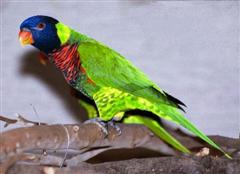Lory - Rainbow (green Naped)
Rainbow Lorikeet, Rainbow Lory, Green Naped Lorikeet, Green Naped Lory, Green Naped Lory Scientific Name: Trichoglossus haematodus
Thu, 10th July, 2025 - 11:51 pm GMT
Sponsor Ads:

Alternative Name
Rainbow Lorikeet, Rainbow Lory, Green Naped Lorikeet, Green Naped Lory, Green Naped Lory Scientific Name: Trichoglossus haematodusBasic Info
The Rainbow Lory can only be described as magnificent. His colors reflect that of an artist's pallet. The primary color of the Rainbow Lory is green, but his plumage is splash with many other colors. Blue is seen on his lores, chin, forehead, forward crown and cheek areas. The blue blends gently into a brownish black towards the back of his head. His breast is a brilliant red. The breast feathers also possess bluish black edging, which lend to a very pretty effect. His nape is a yellowish green with the upper breast and rear cheek areas fading from blue to green. Orange is seen under the wing covets. A striking yellow band is seen on the underside of the flight feathers, while under the tail the plumage is olive yellow. His bill is a distinct orange red color. His eyes possess a reddish-brown iris. They are a larger parrot measuring 10 inches (26cm) in length with wingspans of five and a half to six inches (135 - 150 mm) in length. Immature Rainbow Lories are duller and do not display their full colors until adulthood. Other noticeable differences between immatures and adults are that immatures have dark iris and their bill is a brownish black color. There is no easy way to distinguish males from females. If you want to know what sex your Rainbow Lory is you will need to bring him to your veterinarian for testing. It should be noted that color might also be influenced by diet. Lories that hard not fed nectar in captivity, tend to have a marked difference in color than those that are fed proper diets.
Health
Like all Lories, the Rainbow Lory requires nectar in its diet. It is very important to make sure that your Lory is fed properly; otherwise its health will be affected. Improper feeding and diets can greatly reduce a Rainbow Lory's natural lifespan. Because of their diet, Lories have messy droppings. This needs to be considered before purchase. Suitable cages for the Rainbow Lory must be wide enough to allow space for them to stretch their wings. Natural light is also a requirement, if your house does not offer enough natural light purchase a Vita Light, which is designed to provide the natural light, required by all parrot species.Habitat
Commonly in western New Guinea, Goram Islands, Geelvink Bay, Buru, Ceramlaut, Ceram, Watubela and AmboinaBehavior
The Rainbow Lory is a spectacle to behold with his glorious colorful plumage. It is no surprise that he is a favorite among many bird fanciers. One fancier wrote in that, "There are no other birds as magical and entertaining as a Lory." and the Rainbow Lory allows us to see why! In order to avoid confusion it should be mentioned that the Swainson's Blue Mt. Lorikeet (Trichoglossus haematodus moluccanus) has also been called the Rainbow Lory, but this article will deal with the Green Naped Lory (Trichoglossus haematodus haematodus). It should also be noted that there are at least 21 subspecies of the nominate form Trichoglossus haematodus. Some sources site as many as 22 to 26 different subspecies of lories in the genus of Trichoglossus. The variance is due to the fact that a couple of them are debatable in different research groups. The Rainbow Lory tends to be a one-man bird. Bonding to one person in the family or choosing one particular part of your home as his own is common occurrence. For this reason it is very important that you socialize your Rainbow Lory well. If hand raised they are gentle loving pets that can even be handled by most strangers. They are highly intelligent creatures and for this reason many are able to learn several tricks, sometimes amazingly difficult ones. Because they are so intelligent the Rainbow Lory does require a stimulating environment with several toys. Many Lories enjoy small parrot toys such as wooden blocks or bells. They can be loud, although not as loud as some other parrot species and are generally considered quiet in comparison. While not good talkers many Rainbow Lories are good mimics.Origin
AustraliaHistory
Originating in Australia the Rainbow Lory has a fairly large range in the wild seen commonly in western New Guinea, Goram Islands, Geelvink Bay, Buru, Ceramlaut, Ceram, Watubela and Amboina. There is a lot of confusion around the generic term of "rainbow", in some areas such as the United States. In the US, the term 'rainbow' most commonly refers to a Green Nape Lory since that was the first Lory to become established in the pet trade and often that is the first and/or only Lory that many people come in contact with. Many people may be relatively unaware that lories come in 'different colors'. In other areas, such as Australia the term 'rainbow' may be used in relation to the Blue Mountain Lorikeet, and only to the Blue Mountain only. More than any of group of parrots, this genus is really disserved by using 'common names' and terms. There is still a wide range of temperaments, body language, sizes and tolerances between all of the different Lories called, the "Rainbow Lory". It is very important to make sure what species you are interested in when referring to the Rainbow Lory. Many people end up with the wrong Lory, especially when doing mail order purchases, because of the confusion surrounding the common names.Common Foods
N/ASponsor Ads:
Men are born ignorant, not stupid; they are made stupid by education. -- Bertrand Russell
Lory - Rainbow (green Naped)
Coded by: BGID® | ALL RIGHTS RESERVED Copyright © 2000-2025
Disclaimer | Privacy | Report Errors / Contact | Credits
















